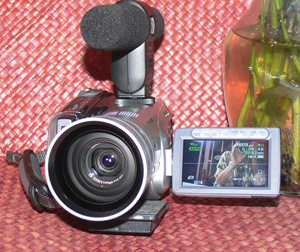david van brink // Tue 2007.10.23 22:08 // {
after effects gear}
Canon HV20
Finally got a pretty decent video camera: a Canon HV20. Just came out earlier this year, and seems to be all the rage; lucky for me it was also what our little town of Santa Cruz had available on a moment’s notice, at Circuit City.

Nice enough. Not as macho as I’d prefer. I got spoiled borrowing a Canon GL2 from work (they use it to make really really bland training videos). This HV20 is tiny, and doesn’t have the overhead microphone/carry-handle and square sunshade of a real indie camera. Adding a gen-u-ine Canon wide angle adapter and accessory-shoe microphone (not a handle!) helps to bulk it up a little. Oh, and to shoot nicer video, too.
The menu system is all right; after a day or two of attention I learned all of it. You can override the focus and the exposure settings somewhat. It has a variable-speed zoom lever; a ring would be nicer.
24P
The HV20 records SD or HD video, apparently at a full 1920 by 1080, which is nice (for reasons I’ll demonstrate in an imminent post). It can record at either 30fps interlaced, or 24fps progressive. That’s cool.
(To recap — interlaced video is full of annoying horizontal stripes, and progressive isn’t. And 24 is the magic frame rate of real movies, so we take it as axiomatic that it’s “better” than 30 or 60 frames per second.)
Unfortunately, it doesn’t tag the firewire stream with the appropriate 24p markers, and applies a 3:2 pulldown automatically. And I read somewhere on the internetz that this was a specific choice by Canon because it’s a “consumer grade” product.
But! No matter. After Effects can fix it, trivially. Just capture the footage at full resolution. I used iMovie to capture, which works great. It offers a choice to capture at 960 by 540 half resolution; don’t do it!
Then import the footage to After Effects. Right click on the asset and choose the “Interpret Footage” menu item. Click the “Guess 3:2 Pulldown” button and ho ho! it doesn’t guess right every time, you may have to try all 10 combinations of upper/lower and five pulldown cadences.

And here are two QuickTimes showing the same footage as captured, and deinterlaced by After Effects 7.0.
24p in glorious 24p
24p with ugly 3:2
These were shot with a 1/1000th second shutter speed, at 33 1/3rd rpm. These movies show a tiny cropped area from the vast HD capture…
Try the QuickTime single step buttons (or left/right arrow keys) to see the difference between glorious 24fps and ugly, ugly 3:2 pulldown at 30fps. Glorious!
